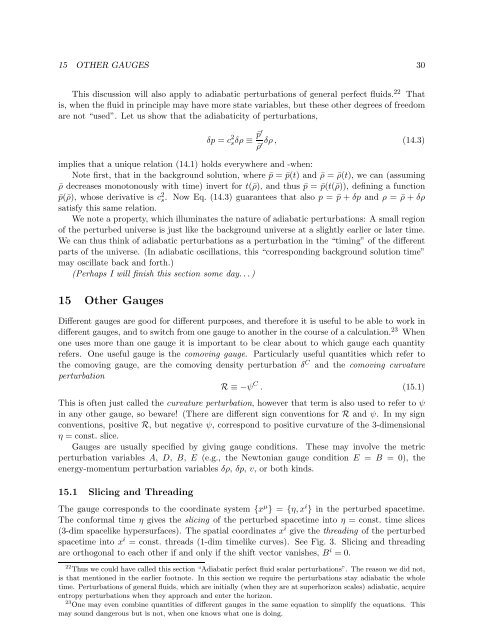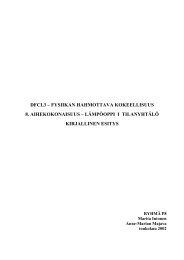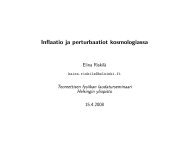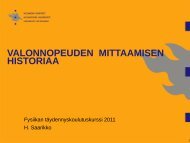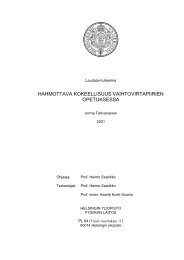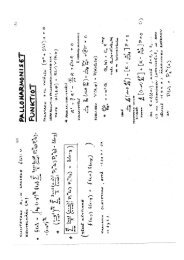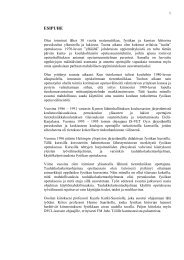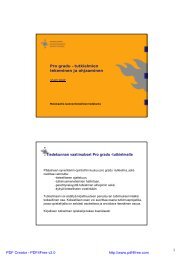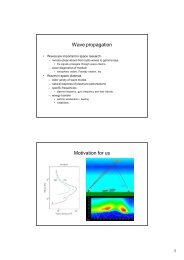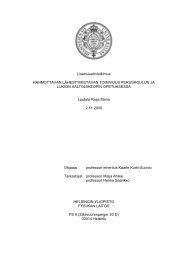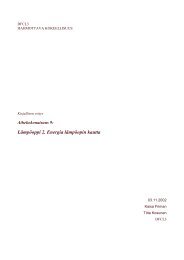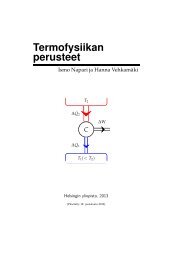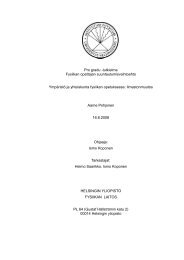Cosmological Perturbation Theory, 26.4.2011 version
Cosmological Perturbation Theory, 26.4.2011 version
Cosmological Perturbation Theory, 26.4.2011 version
You also want an ePaper? Increase the reach of your titles
YUMPU automatically turns print PDFs into web optimized ePapers that Google loves.
15 OTHER GAUGES 30This discussion will also apply to adiabatic perturbations of general perfect fluids. 22 Thatis, when the fluid in principle may have more state variables, but these other degrees of freedomare not “used”. Let us show that the adiabaticity of perturbations,δp = c 2 sδρ ≡ ¯p′¯ρ ′δρ, (14.3)implies that a unique relation (14.1) holds everywhere and -when:Note first, that in the background solution, where ¯p = ¯p(t) and ¯ρ = ¯ρ(t), we can (assuming¯ρ decreases monotonously with time) invert for t(¯ρ), and thus ¯p = ¯p(t(¯ρ)), defining a function¯p(¯ρ), whose derivative is c 2 s. Now Eq. (14.3) guarantees that also p = ¯p + δp and ρ = ¯ρ + δρsatisfy this same relation.We note a property, which illuminates the nature of adiabatic perturbations: A small regionof the perturbed universe is just like the background universe at a slightly earlier or later time.We can thus think of adiabatic perturbations as a perturbation in the “timing” of the differentparts of the universe. (In adiabatic oscillations, this “corresponding background solution time”may oscillate back and forth.)(Perhaps I will finish this section some day...)15 Other GaugesDifferent gauges are good for different purposes, and therefore it is useful to be able to work indifferent gauges, and to switch from one gauge to another in the course of a calculation. 23 Whenone uses more than one gauge it is important to be clear about to which gauge each quantityrefers. One useful gauge is the comoving gauge. Particularly useful quantities which refer tothe comoving gauge, are the comoving density perturbation δ C and the comoving curvatureperturbationR ≡ −ψ C . (15.1)This is often just called the curvature perturbation, however that term is also used to refer to ψin any other gauge, so beware! (There are different sign conventions for R and ψ. In my signconventions, positive R, but negative ψ, correspond to positive curvature of the 3-dimensionalη = const. slice.Gauges are usually specified by giving gauge conditions. These may involve the metricperturbation variables A, D, B, E (e.g., the Newtonian gauge condition E = B = 0), theenergy-momentum perturbation variables δρ, δp, v, or both kinds.15.1 Slicing and ThreadingThe gauge corresponds to the coordinate system {x µ } = {η,x i } in the perturbed spacetime.The conformal time η gives the slicing of the perturbed spacetime into η = const. time slices(3-dim spacelike hypersurfaces). The spatial coordinates x i give the threading of the perturbedspacetime into x i = const. threads (1-dim timelike curves). See Fig. 3. Slicing and threadingare orthogonal to each other if and only if the shift vector vanishes, B i = 0.22 Thus we could have called this section “Adiabatic perfect fluid scalar perturbations”. The reason we did not,is that mentioned in the earlier footnote. In this section we require the perturbations stay adiabatic the wholetime. <strong>Perturbation</strong>s of general fluids, which are initially (when they are at superhorizon scales) adiabatic, acquireentropy perturbations when they approach and enter the horizon.23 One may even combine quantities of different gauges in the same equation to simplify the equations. Thismay sound dangerous but is not, when one knows what one is doing.


